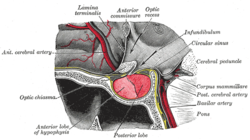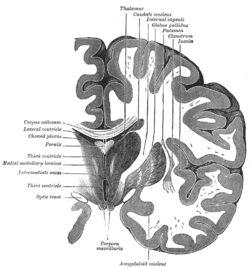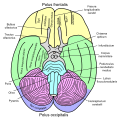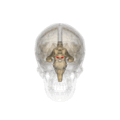- Mammillary body
-
Brain: Mammillary body 
The hypophysis cerebri in position. Shown in sagittal section. (Label "corpus mamillare" at right.) 
Coronal section of brain through intermediate mass of third ventricle. (Label "corpora mamillaria" at bottom.) Latin corpus mamillare Gray's subject #188 813 Part of Midbrain System Limbic Components medial mammillary nucleus
lateral mammillary nucleusAcronym(s) mmb NeuroNames hier-395 MeSH Mamillary+Bodies NeuroLex ID birnlex_865 The mammillary bodies (mamillary bodies) are a pair of small round bodies, located on the undersurface of the brain, that, as part of the diencephalon form part of the limbic system. They are located at the ends of the anterior arches of the fornix. They consist of two groups of nuclei, the medial mammillary nuclei and the lateral mammillary nuclei.[1]
Neuroanatomists have often categorized the mammillary bodies as part of the hypothalamus.[2]Contents
Connections
They are connected to other parts of the brain (as shown in the schematic, below left), and act as a relay for impulses coming from the amygdalae and hippocampi, via the mamillo-thalamic tract to the thalamus.
This circuit, from amygdalae to mammillary bodies, and then on to the thalamus, is part of the larger 'Papez circuit'.
Function
They, along with the anterior and dorsomedial nuclei in the thalamus, are involved with the processing of recognition memory.
They are believed to add the element of smell to memories.
Pathology
Damage to the mammillary bodies due to thiamine deficiency is implied in pathogenesis of Wernicke-Korsakoff syndrome. Symptoms include impaired memory, also called anterograde amnesia, suggesting that the mammillary bodies may be important for memory. Lesions of the medial dorsal and anterior nuclei of the thalami and lesions of the mammillary bodies are commonly involved in amnesic syndromes in humans.[3]
Additional images
References
- ^ http://www.cf.ac.uk/psych/resources/vann2004.pdf Reference for the two groups of nuclei (not for the text before).
- ^ M.B. Carpenter and J. Sutin: Human Neuroanatomy (8th edition) 1983
- ^ Duprez T, Serieh B, Raftopoulos C (1 January 2005). "Absence of memory dysfunction after bilateral mammillary body and mammillothalamic tract electrode implantation: preliminary experience in three patients". AJNR. American journal of neuroradiology 26 (1): 195–7; author reply 197–8. PMID 15661728. http://www.ajnr.org/cgi/content/full/26/1/195.
External links
- Vann S, Aggleton J (2004). "The mammillary bodies: two memory systems in one?". Nat. Rev. Neurosci. 5 (1): 35–44. doi:10.1038/nrn1299. PMID 14708002. http://www.cf.ac.uk/psych/resources/vann2004.pdf.
- TheFreeDictionary.com - 'Mammillary body'
- Roche Lexicon - illustrated navigator, at Elsevier 13048.000-3
Papez circuit pathway Diencephalon Telencephalon Anterior limb of internal capsule → Cingulate gyrus → Cingulum → Parahippocampal gyrus → Entorhinal cortex → Perforant path → Hippocampus/Hippocampal formation (CA3 → CA1 → Subiculum) → Fornix →Categories:- Limbic system
- Neuroscience stubs
Wikimedia Foundation. 2010.




